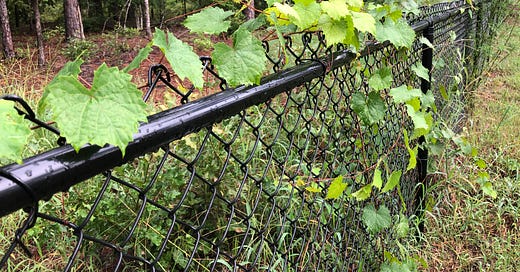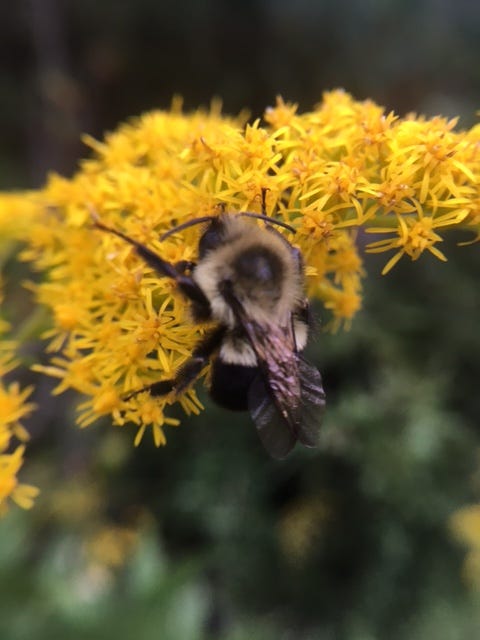A few days ago, I noticed some muscadine vines growing on our chain-link fence bordering the woods. I really didn't mind because I like to eat muscadines. So, I left them in place. Now, I'm having second thoughts.
These native grapes grow wild around here, and wildlife feasts on the juicy fruits in autumn. However, the muscadine vines can get out-of-hand, smothering trees, bushes, and every other plant in their path.
Should I leave them for the birds, critters, (and myself), or should I chop them down before the aggressive vines overtake all the greenery bordering our backyard?
Aggressive vs Invasive
Many naturalists tend to say that native species that bully their way through an ecosystem, smothering out other beneficial plants are aggressive. They have a mind of their own. However, they benefit nature by providing food and shelter for insects and wildlife sharing the same turf.
For instance, Canada Goldenrod (Solidago canadensis) or Common Milkweed (Asclepias syriaca) spread extensively by rhizomes and create large stands, choking out all the wildflowers standing in their way. On the other hand, goldenrod and milkweed are beneficial plants. In autumn, when other food resources are waning, goldenrod is a keystone plant providing nectar, pollen, and seeds for a large variety of insects and birds preparing for winter. As far as milkweed goes, Monarch butterflies lay their eggs only on milkweed, and the caterpillars feed exclusively on these plants. Plus, many other insects take advantage of milkweed as well
.Of course, aggressive indigenous plants are not ideal choices for landscaping our yards, but they do play a vital role in nature's balance. Besides, we can find better-behaved species of goldenrod and milkweed to use in the garden—just research which ones are native to your area.
Conversely, Invasive plants serve absolutely no ecological purpose. Plus, they can spread rapidly, displacing the diverse vegetation indigenous insects and wildlife depend on to survive. According to the National Invasive Species Council, "They are not native to the ecosystem and can cause economic or environmental harm or harm human health. Invasive plants can spread, reduce crop yields, or reduce the number of desirable species."
In other words, they're a royal pain and an environmental conservationist's worst nightmare.
Sure, English Ivy looks great growing along a retaining wall, but when it takes over the neighboring woodlands, it's a menace. Not only do the plant's roots travel underground, but birds and animals also carry the seed-filled berries hither, thither, and yon
These quick-growing and at times, very aggressive plants take over the land, choking out the native species that have no defense against the overwhelming bullies. As a result, conservationists working to restore woodlands, prairies, wetlands, and other threatened ecosystems spend countless hours removing destructive plants only to have more unwanted seedlings spring up in their place. From my perspective, it's a never-ending battle, and I'm not sure who's winning. Also, remember, it's not only English Ivy they're fighting, but hundreds, if not thousands of other habitat snatchers lurking out there as well.
The National Wildlife Federation reports that thousands of native-plant species are at risk of extinction. According to NWF's chief scientist, Bruce Stein, "If we are interested in conserving the diversity of life on Earth, we need to be very concerned about the large numbers of at-risk and declining [native] plants."
Okay, What Does This Mean to Us?
As a gardener cultivating a pollinator paradise, invasive plants can drive you crazy. The nasty alien invaders creep up from the soil, choking out the native flora you've so carefully nurtured to benefit the local insects and wildlife. Overnight, the nasty, unwelcomed guests move in and prove impossible to evict.
Why are invasive plants so successful? (From the U.S. Forestry Service:)
They produce large quantities of seed.
They can thrive in any type of soil.
Invasive plant seeds are often distributed by birds, wind, or humans, allowing them to move great distances.
Some Invasives have aggressive root systems that spread long distances from a single plant.
These root systems often grow so densely that they smother the root systems of the surrounding vegetation.
Some plant species produce chemicals in their leaves or root systems, which inhibit the growth of other plants around them.
Where Do Invasive Plants Come From?
Unfortunately, many have been (and still are) being introduced by people buying exotic plants for their gardens. Stores and nurseries sell what the public wants. Therefore, they stock listed invasive plants such as butterfly bush and burning bush. They also import exotic flowers, shrubs, bushes, and trees from other parts of the world, selling them to homeowners nationwide.
However, the importation and spread of non-native plants aren't anything new. It's been going on since immigrants settled in America. Colonists brought many plants from their homelands, and the foreign grasses and flora were sown from the East Coast to California as the settlers migrated west. It was one of our ancestors who originally planted that bothersome English Ivy around their homestead. Unfortunately, when folks discovered the plant was a nuisance, it was too late, and we have been suffering the consequences ever since.
Next week, we'll continue talking about what kind of non-native plants to avoid and native alternatives to them. Please take this seriously. We've got to stop the destruction of habitats and ecosystems. We can all play a significant role by not spreading unwanted plants.
Meanwhile, what did I do about the muscadines? The vines are still on the fence. If they start spreading into the woods, I'll uproot them. Until then, I'm looking forward to eating some this autumn.
~~~~~~~~~~~~~~~~~~~~~~~
Dear Reader,
I’d be ever so grateful if you would take a few minutes to recommend Let’s Get Our Hands Dirty to your followers on Substack and other social media platforms.
Thank you!
Greta
---------------------------
Let’s Get Our Hands Dirty is a reader-supported publication. This post is free as are all my posts. Please subscribe so you can receive notification when new articles are published. I’d love for you to become a part of our nature-loving family. Basic subscriptions are free, but if you sign up for a paid subscription as a love offering, that would be wonderful and greatly appreciated!
Have a fabulous day,
Greta
Please use the buttons below to Like, Comment, Restack, and Share my post on Substack and other social media platforms.
THANK YOU SO MUCH!









I had no idea those grapes are aggressive. Another bad one is Lily of the Valley.